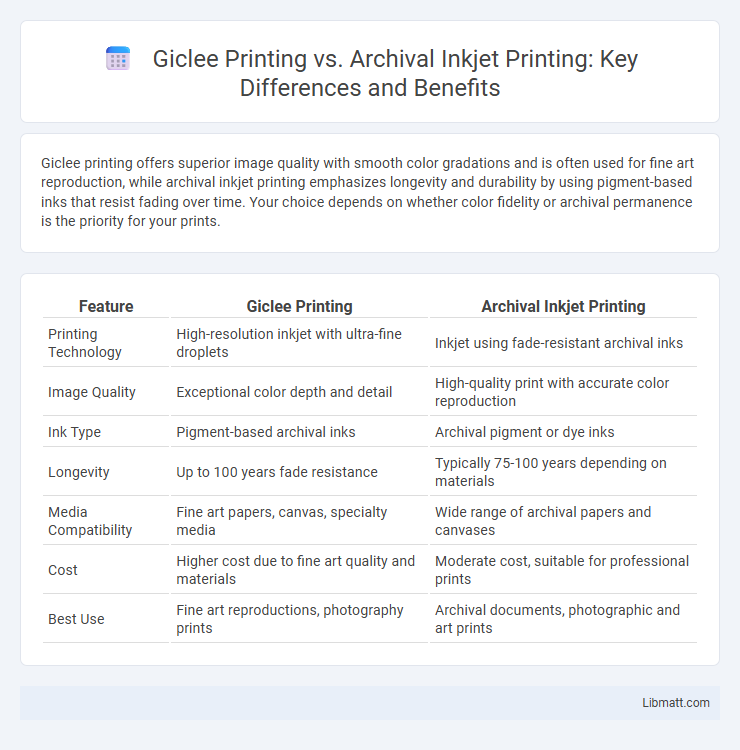Giclee printing offers superior image quality with smooth color gradations and is often used for fine art reproduction, while archival inkjet printing emphasizes longevity and durability by using pigment-based inks that resist fading over time. Your choice depends on whether color fidelity or archival permanence is the priority for your prints.
Table of Comparison
| Feature | Giclee Printing | Archival Inkjet Printing |
|---|---|---|
| Printing Technology | High-resolution inkjet with ultra-fine droplets | Inkjet using fade-resistant archival inks |
| Image Quality | Exceptional color depth and detail | High-quality print with accurate color reproduction |
| Ink Type | Pigment-based archival inks | Archival pigment or dye inks |
| Longevity | Up to 100 years fade resistance | Typically 75-100 years depending on materials |
| Media Compatibility | Fine art papers, canvas, specialty media | Wide range of archival papers and canvases |
| Cost | Higher cost due to fine art quality and materials | Moderate cost, suitable for professional prints |
| Best Use | Fine art reproductions, photography prints | Archival documents, photographic and art prints |
Understanding Giclée Printing
Giclee printing is a high-quality inkjet printing process that uses archival pigment-based inks to produce vibrant, long-lasting images with exceptional color accuracy and fine detail. This method typically employs high-resolution printers and specialized papers or canvases designed to enhance durability and resist fading over time. Unlike standard archival inkjet printing, Giclee emphasizes museum-grade output suitable for fine art reproductions and professional photography.
What Is Archival Inkjet Printing?
Archival inkjet printing refers to a high-quality digital printing process using pigment-based inks designed to ensure longevity and color stability over time, often exceeding 100 years under proper conditions. This method deposits tiny droplets of archival-grade ink onto fine art paper or canvas, producing vibrant, detailed images resistant to fading and environmental damage. Giclee printing is a type of archival inkjet printing specifically recognized for its meticulous color accuracy and use of premium archival materials.
Key Differences Between Giclée and Archival Inkjet
Giclee printing utilizes high-quality pigment-based inks and specialized printers to produce vibrant, gallery-grade art prints on archival substrates, ensuring longevity of up to 100 years or more without color fading. Archival inkjet printing also employs pigment inks but is often used for broader applications, including photographic prints and fine art reproductions, focusing on fade resistance and color accuracy with slightly less precision than Giclee. The key differences lie in the printing resolution, ink formulation, and substrate compatibility, with Giclee emphasizing ultra-fine detail and color depth for professional art markets.
Print Quality and Color Accuracy Comparison
Giclee printing employs high-resolution inkjet technology with pigment-based archival inks, delivering exceptional print quality characterized by sharp detail and smooth color gradients. Archival inkjet prints also use pigment or dye-based inks designed for longevity, but Giclee typically offers superior color accuracy due to its wider color gamut and precise ink layering. Both methods produce durable prints, but Giclee printing is preferred by professionals seeking gallery-grade reproductions with vibrant, true-to-original colors.
Longevity and Fade Resistance
Giclee printing offers exceptional longevity with high-quality archival inks that resist fading for up to 100 years when properly displayed and stored. Archival inkjet prints also provide strong fade resistance, but their durability can vary depending on the ink and paper quality used. Your choice between the two should consider the specific archival standards and environmental conditions to ensure maximum preservation of your artwork.
Paper and Media Compatibility
Giclee printing excels in paper and media compatibility, supporting a wide range of fine art papers, canvas, and textured surfaces designed for gallery-quality reproductions. Archival inkjet printers also provide robust media flexibility but are optimized for longevity and color accuracy on specific archival-grade substrates. Your choice depends on the balance between media variety and the desired archival standards for preservation.
Suitable Applications for Each Method
Giclee printing excels in high-quality art reproductions, fine art prints, and limited edition prints due to its superior color accuracy and wide color gamut. Archival inkjet printing is ideal for documents, photographs, and proofs that require longevity and resistance to fading over time. Both methods serve professional printing needs but differ in their applications based on quality requirements and material compatibility.
Cost Considerations and Value
Giclee printing typically involves higher production costs due to the use of specialized archival inks and premium paper, resulting in superior color fidelity and longevity. Archival inkjet prints offer a more budget-friendly alternative while still maintaining impressive durability and print quality. Your decision should weigh the balance between initial investment and long-term value, especially for fine art reproductions or limited editions where archival integrity is paramount.
Collectors’ and Artists’ Preferences
Collectors and artists favor Giclee printing for its superior color accuracy and longevity, achieving museum-quality reproductions with archival pigment inks on fine art papers. Archival inkjet prints also appeal due to their extended fade resistance and ability to capture intricate details, making them ideal for limited edition artworks. Preference often hinges on the specific ink formulation and substrate quality, which directly impact the artwork's durability and vibrancy over time.
Choosing the Right Printing Method for Your Artwork
Selecting the right printing method for your artwork depends on factors like color accuracy, longevity, and paper compatibility. Giclee printing offers superior color depth and uses archival-quality inks that resist fading for up to 100 years, ideal for fine art reproductions. Archival inkjet printing provides durability and cost-effectiveness, making it a practical choice for limited edition prints and personal collections.
Giclée printing vs archival inkjet Infographic

 libmatt.com
libmatt.com